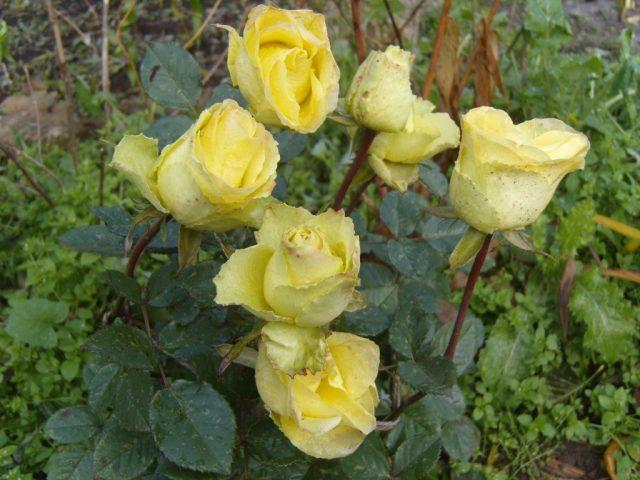Content
Rose Limbo is an amazing variety of hybrid tea, ideal for cutting and making wonderful flower arrangements. It feels good in open ground, grows in greenhouses, and is suitable for growing in containers. The plant is relatively undemanding to care, has high decorative qualities and interesting bud colors. In recent years, it has become increasingly appearing in flower beds and being used by landscape designers to decorate areas.

Limbo is an unusual yellow-green hybrid variety.
History of origin
Limbo has a long history and unofficial status as a green rose. It appeared in 1999, thanks to the work of the German breeder Wilhelm Cordes.
Description of the rose variety Limbo with photo
Green Limbo roses are compact, cone-shaped bushes that grow to a maximum of 0.8 m in height. Their diameter does not exceed 0.6 m. The shoots of the plant are strong, powerful, erect, have practically no thorns, and are leafy quite densely.Limbo's leaf blades are large, dense and shiny. The buds are densely double, have a cone shape, petals with a wavy edge in an amount of up to 47 pieces. When the cup is fully opened, the flowers can reach a diameter of 9 cm. They are located on long stems one at a time, which is why they are ideal for cutting and look great in bouquets.
The color of the buds is pale, light yellow, slightly greenish, sometimes lemon or salad green; under the sun it can fade to white, but the border will still remain a lime color. Black stamens are visible in the center of the flower. The aroma of Limbo roses is light and barely noticeable; you can feel it only by leaning close to the bush.
During the summer the variety blooms twice. The first time was from the last days of June until the beginning of August, the second time - towards the end of summer and until winter. The opening of the buds occurs very slowly; they last on the bushes for about a month, and in a vase they remain decorative for two weeks. Flowering is observed even on young plants; it is not particularly abundant, but it cannot be called sparse either.
The Limbo rose variety has good resistance to cold, frost hardiness zone 6. Without shelter, the plant overwinters at temperatures down to -23 °C. If you grow it in the northern part of Russia, then with the approach of cold weather, the base of the bush needs to be hilled up or covered with humus and peat up to 30 cm in height, covered with spruce branches on top, and a box or a special cover made of covering material should be placed on the remaining part of the plant above the ground.
The main characteristics of the Limbo rose include the fact that it is not afraid of rain, but it lacks good immunity.There are often cases when a bush suffers from common diseases, which is why it needs regular preventive treatments. It should also be noted that the variety does not tolerate pruning well, does not differ in growth rate, and does not need frequent pruning. But in order for the plant to look aesthetically pleasing and bloom well, it requires the removal of faded buds.

Because of its original color, the Limbo rose is popularly called the dollar.
Advantages and disadvantages
The Limbo variety, despite its amazing beauty and a large number of advantages, also has a number of disadvantages that are important to consider during cultivation.

The unusual color of the hybrid buds compensates for all its negative qualities
Advantages:
- original color of petals;
- re-blooming;
- good resistance to cold;
- a small number of thorns;
- rain resistance;
- suitability for cutting;
- slow opening of buds.
Flaws:
- susceptibility to powdery mildew and spotting;
- slow growth;
- poor combination with other ornamental crops;
- long period of adaptation of seedlings.
Features of cultivation
The Limbo rose has its own characteristics, which are recommended to be taken into account during its cultivation in order to get a positive result from flowering. The buds of this variety will be saturated only in partial shade. If you plant it in the shade, the bush will stop growing, and in the sun the flowers will turn white.
A place for the plant should be chosen without drafts, preferably near a wall or fence. The soil should be loose and nutritious; loam or sandy loam is best.In addition to open ground, the rose grows well in greenhouses and greenhouses, and can be planted in pots and containers. The favorable temperature regime for the plant is considered to be from +23 to +28 °C; in hot weather from +33 °C the bush begins to lag behind in development.
As for planting, when growing a crop in a temperate climate, it begins to be planted around mid-May, when the soil warms up to +10 °C and above. And in the southern districts, Limbo can be planted in the ground in the fall, up to the 15th of October. The seedlings you choose should be strong, two to three years old, with four to five healthy shoots no shorter than 25 cm in length. The roots should be flexible, about 30 cm in size.
The rose is planted in deep (50 cm) holes with a drainage layer, covered with purchased soil with the addition of special fertilizer for roses, and mulched. A canopy is installed over the bush and is not removed until the plant takes root.
When caring for the crop, water it once a week, or twice in hot weather, without allowing the water to stagnate. After moistening, the soil is loosened, weeds are removed, and the mulch is renewed if necessary. Limbo is fertilized often: in early spring with nitrogen mineral compounds and humus, every two weeks until the buds form with organic substances, then 2-3 times a month with complex fertilizers. They stop fertilizing in mid-September.
How does it reproduce
Lemon hybrid tea rose Limbo is mainly propagated by cuttings. The shoots from it are cut in mid-summer; their length should be about 13 cm, with several growth buds present.For successful propagation, the cuttings are first soaked in a biostimulant, and then rooted in a mixture of sand and peat, under a film. The planting material that has given roots is planted for next year in the spring.

Limbo rose cuttings take root with a probability of 50-60%
Pest and disease control
Rose variety Limbo has low resistance to such unpleasant diseases as rust, powdery mildew, and black spot. To prevent contamination of the crop, gardeners regularly carry out preventive spraying with special means. If it is still not possible to protect the bush, then you have to cut it heavily and repeatedly treat it with copper sulfate.
Pests also often attack the Limbo rose. Among the most common are aphids, caterpillars, ants, leaf rollers, and sawfly beetles. To combat them, both folk remedies and chemicals are used.
Application in landscape design
Due to the fact that the buds of the Limbo rose have an unusual color, finding varieties of a successful companion is quite problematic. According to experts, it is best to choose the rose William Shakespeare 2000 (William Shakespeare), plants of cool shades and conifers with dark-colored needles as a neighbor for this crop. It looks good with clematis, irises and lavender.

From a distance you may not even see the buds of the Limbo rose
Conclusion
Although Rose Limbo is not considered a particularly fancy variety, it can sometimes force a gardener to work hard to grow it. Its lush and abundant flowering can be achieved only with proper care and compliance with all agrotechnical rules. Every year the Limbo variety is gaining more and more popularity, but flower growers advise only those who have experience in growing roses to acquire it.
Reviews of rose Limbo








